Cal Fire's Fearless Flying Firefighters


Relive the excitement of man’s first steps on the moon and the long journey it took to get there with 20 new hours of out of this world programming on KCET's “Summer of Space" Watch out for “American Experience: Chasing the Moon” and a KCET-exclusive first look at "Blue Sky Metropolis," four one-hour episodes that examine Southern California’s role in the history of aviation and aerospace.
The thought of flight and the consuming power of fire has fascinated mankind for centuries. Who hasn’t looked up wondering what it would be like to soar among the clouds? Who hasn’t sat mesmerized, staring into a campfire? The translucent red flames reaching toward the sky somehow hold us captive. For a select few, fire and flight go hand in hand.
“Like most kids, I wanted to be an astronaut,” says helicopter pilot Cliff Walters. Walters learned to fly in the army. After three years serving as a medic, he reenlisted, specifically to become a pilot. He served as a wildland firefighter for several seasons, then worked with the San Bernardino County Sheriff’s Department as a helicopter pilot. Fighting fires from the skies for the last twenty years, Walters flies a UH1H Super Huey as a forestry fire pilot. “In Southern California, we live each day with the thought of fire.”
Aerial Firefighting
“When the bell rings we deploy. All the firefighting gear sits ready on the helicopter. The crew, two fire captains and five firefighters jump in, and we are in the air in under five minutes. We recon the fire, I set down and deploy the crew, then head to the nearest water source,” says Walters. As the firefighters make a fire line, separating the dry fuel from the vegetation, Walters locates the closest water source to fill the water tank on the belly of his helicopter. Eighteen inches of water is all that is needed to submerge the snorkel, allowing Walters to take water from ponds, lakes or streams. In mere seconds, roughly 375 gallons of water are loaded through the 12-foot-long dangling snorkel while the helicopter hovers in place.
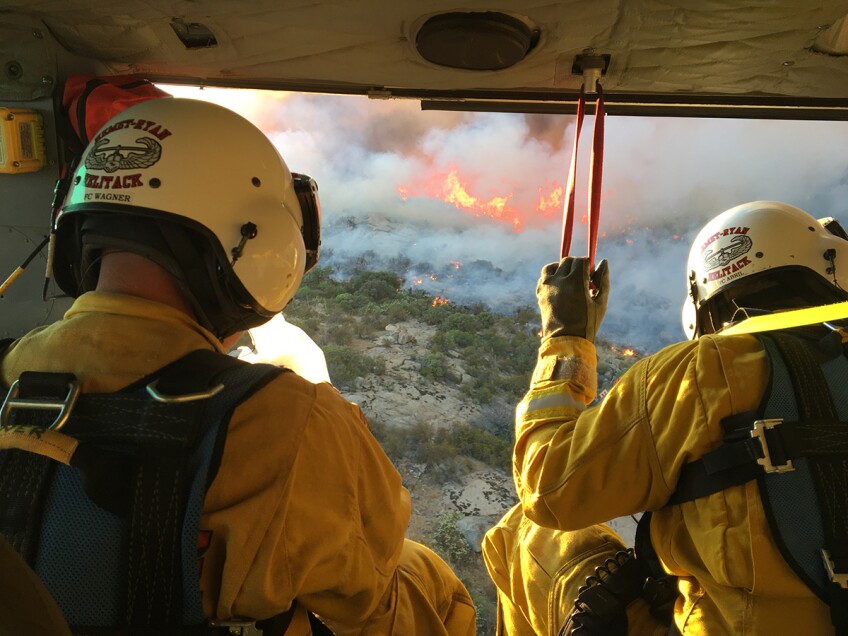
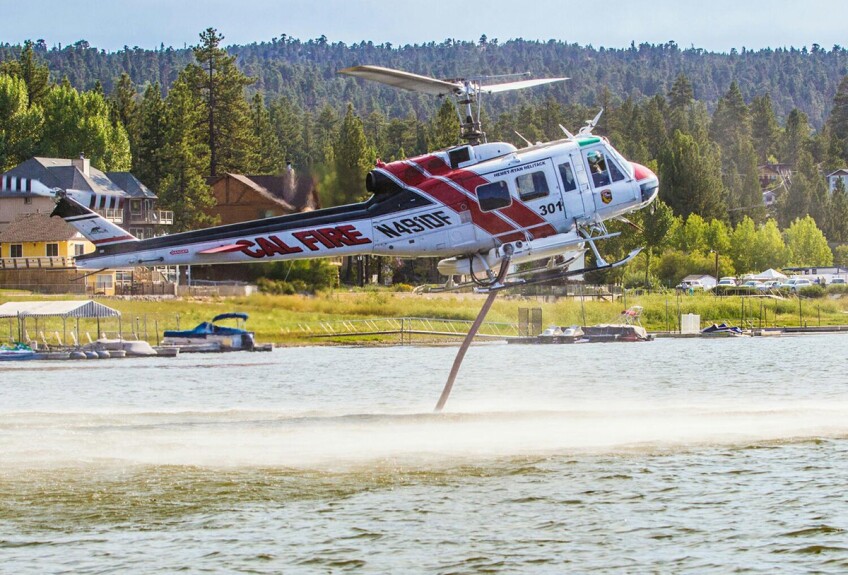
“Flying at 100 mph, twenty seconds to fill the tank, then back to the fire to drop water. At a recent fire, I was dropping water every three to five minutes.” Walters explains he controls the amount and speed of the water as he drops it out of his tank from 50 to 100 feet above the ground. Those seconds flying near the ground at a slow speed are the most dangerous, where there is zero room for error. Pilots must have excellent situational awareness. Knowing what is above, below, in front and next to them at all times is critical.
“There can be 10 to 12 aircraft in a small space when working a big fire. The air attack plane is 2,500 feet above the fire; the air tankers are coming in to drop retardant every 20 to 30 minutes, then the helicopters work below the tankers dropping water,” he said. “Aerial firefighting requires exact communication; each person must follow the plan to ensure everyone’s safety and complete the mission successfully.”
Walters is part of the Cal Fire team. The California Department of Forestry and Fire Protection is the state’s emergency response and resource protection agency that answers diverse emergency calls, such as floods, earthquakes, search and rescues, medical emergencies and fires, to name a few. Cal Fire has 13 airbases and 10 helicopter bases placed strategically throughout the state, enabling air resources and personnel to be on the scene of a fire, anywhere in the state, in under 20 minutes.
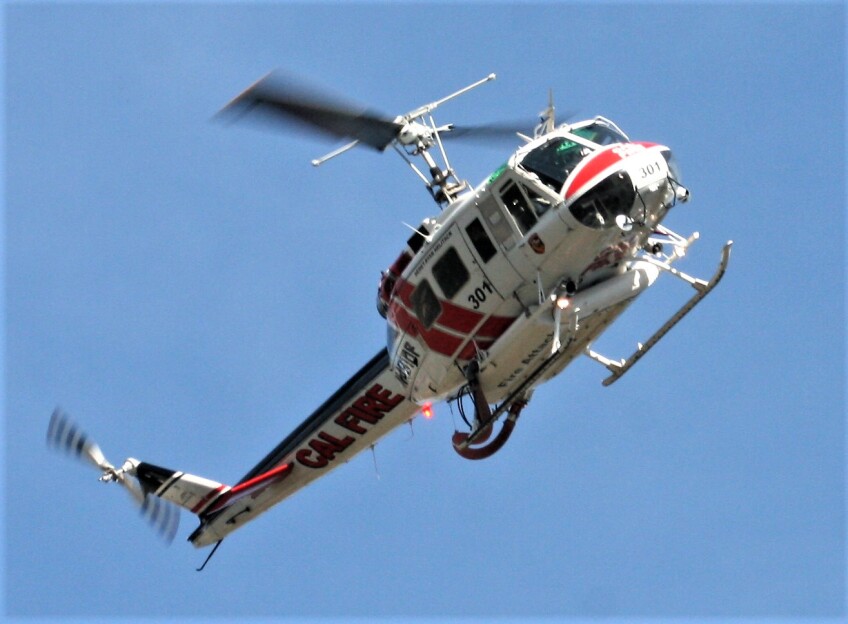
Cal Fire responds to 6,300 wildfires and more than 300,000 emergency calls in an average year and is globally recognized for its premier firefighting aviation program. Because of the organization’s expertise, quick, efficient response and team effort, Cal Fire extinguishes most fires while they are small.
As firefighting pilots, “our primary mission is to support the ‘boots on the ground.’ Our objective is to slow the progression of fires by strategically dropping water and retardant to maintain a fire line. Cooling the most intense hot spots enables the firefighters to get in there and do their job. Ultimately, the goal is to extinguish the fire, preserving life and property.” Walters says. “I have spent more than enough time up close and personal fighting fires to know I’d rather be in the helicopter.”
If a fire begins with the Santa Anna winds blowing, there isn’t anyone or anything that can stop that fire. We have always had a history of large fires in California. In 2003, we had three large fires burning simultaneously: The Cedar Fire, Grand Prix and the Old Fire. There were over 9,000 fires that year that burned a million acres and claimed 24 lives. I fly over those same areas today, remembering those fires. My 375 gallons of water is a drop in a bucket with those big fires, but I see that one tree standing taller than the others, I know that I saved that one. For every big fire that makes the news, we put out hundreds of small fires that no one knows about. My work is rewarding; sometimes, you have to be happy with small victories.”
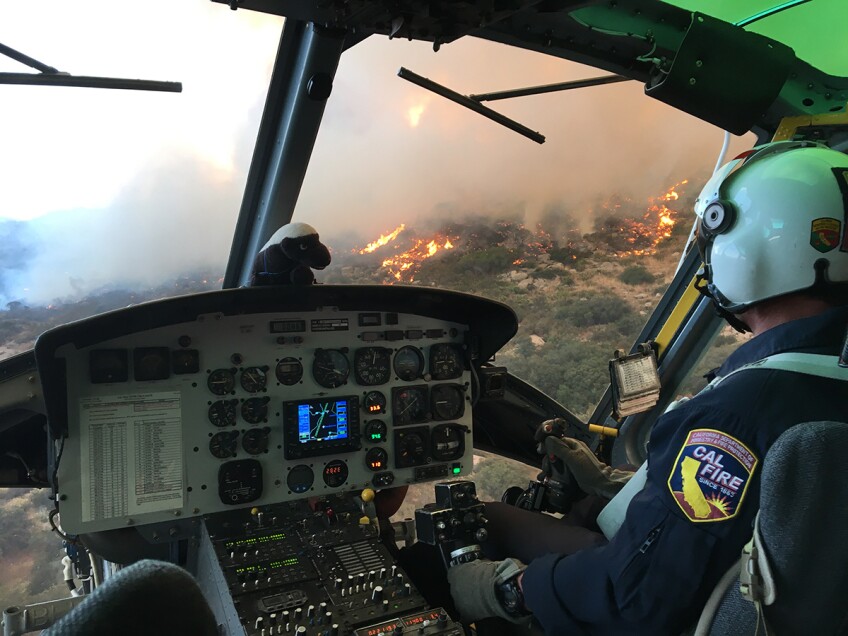
Wildland firefighters, supervisors, mechanics, pilots and support staff are stationed at the bases during fire season with the mission of doing all that's in their power to knock down fires with the initial attack to minimize loss. Their fleet of aircraft includes 23 air tankers, 12 helicopters, 15 air tactical aircraft and two tactical training aircraft.
The air tactical aircraft, North American Rockwell OV-10As, serve as the command post in the sky. The birds-eye view enables this mobile command post to keep abreast of the fire and its ever-changing conditions. Providing tactical coordination in conjunction with the ground crew, pilots are directed to critical locations where water and retardant are most needed. Cal Fire’s Grumman S-2T airtankers are the fire trucks in the sky, each carrying 1,200 gallons of water or retardant. The helicopters provide the critical rapid response needed for recon missions, transportation of firefighters and equipment and emergency medical transport when needed.
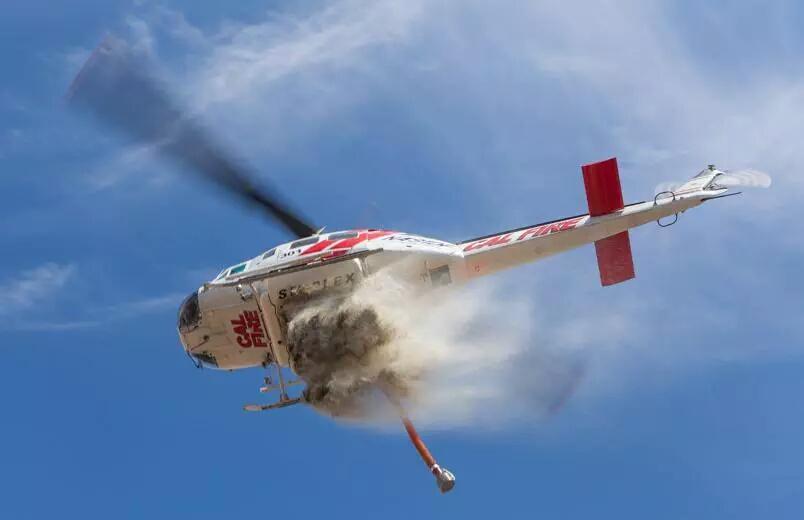
Cal Fire has two Helitack bases in Southern California: Prado Helibase near Chino and Ryan Air Attack Base in Hemet. Hemet is one of only two bases in the state that deploy helicopters, airtankers and air tactical planes. Working out of the base in Hemet, Walters is often called to rescue hikers and hang gliders. "We typically have three to four rescues a month,” Walters says. “A hoist is installed in the helicopter; rescue gear is loaded and two EMT trained firefighters jump on for the rescues. We serve primarily as a rescue ship, handing off the injured person to an ambulance crew or Mercy Air for transport, but if needed we continue to the hospital.”
Walters speaks of lowering the hoist to rescue hikers, flying his helicopter over fires, hovering over lakes and dropping water out of the sky like it’s not a big deal, but he is quick to point out that success of every mission depends on a team effort.
Support from Below Keeps Them in The Air
Those responsible for maintaining the aircraft are a critical part of that team. Ensuring each aircraft performs at the highest level falls on the shoulders of DynCorp International’s maintenance crews out of Sacramento. DynCorp and Cal Fire enjoy a close relationship in which DynCorp is subcontracted to supply the fixed-wing pilots and aviation maintenance personnel. “We all work together to protect lives and resources,” says Jesse Potswald, DynCorp fixed wing maintenance supervisor. “Maintaining the fleet of aircraft to facilitate peak performance and minimizing downtime enables those assets to be fully utilized.”
Combining his love of “tinkering with anything mechanical” and his dream of becoming a pilot, Potswald considered training as an aviation mechanic as a step toward making his dream a reality. “The aeronautics technician program gives you a knowledge base to build on. Cal Fire’s unique fleet of aircraft presents opportunities and challenges not found elsewhere. We work on aircraft that you wouldn’t see in commercial aviation.”
“Field mechanics stationed at the bases are the first line of defense,” Potswald explains. “Technicians troubleshoot issues, completing repairs on-site, avoiding aircraft downtime. When there are complex issues, DynCorp has personnel available that specialize in avionics, electronics, engines, structures and sheet metal.” Potswald goes on, “Each aircraft undergoes daily pre-fight inspections and is also checked during retardant-loading and refueling. Our days vary from performing routine maintenance to all-hands-on-deck when the base is working an active fire that necessitates multiple aircraft coming and going.”
Just as aircraft pioneers Doug Douglas and Allan Lockheed rebuilt commercial planes for military use in the late ‘30s, Cal Fire and DynCorp technicians modify and rebuild legacy military aircraft, repurposing them for firefighting missions. “The Grumman S-2, Rockwell OV-10 and Bell UH-1H were all former U.S. military aircraft with years of proven ruggedness, reliability and service during both wartime and peacetime. Because of the extreme and adverse conditions [of] flying over fires, it’s only fitting that these airframes were chosen for a new role. Through extensive modifications and remanufacturing, these former military aircraft were modernized and given a second chance at life with new missions,” says Potswald.
At the height of the war effort, Southern California was the center of the aircraft industry. The assembly line of round-the-clock workers was able to turn out one aircraft every 12 minutes. “I thought I knew planes, but building one from the ground up is an entirely different animal,” says Potswald. One of the most remarkable projects he has taken part in, building an air tanker from the ground up, is affectionately called “Project X.”
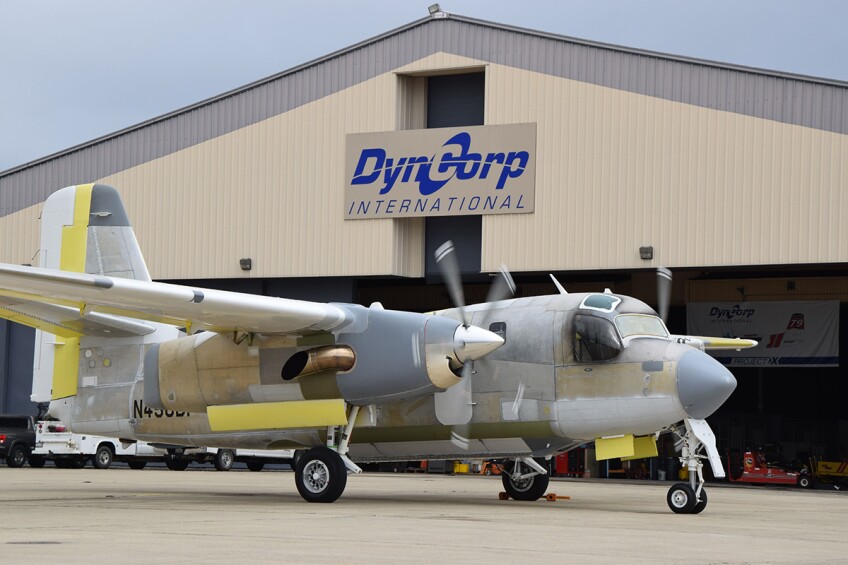
Potswald explains, “Beginning in March of 2016, we started with a surplus Grumman S-2G that was parked in the desert since 1974. It was trucked up from Arizona to DynCorp’s facility at McClellan. Stripped of all its armament and original systems until only a shell remained, we started the de-mill process and cut out the center section of the belly where the torpedoes were once kept, making room for the 1,200-gallon retardant tank.”
We removed the engines, all the wiring, wings, tail and landing gear then started the process of repairing any preexisting damage and defects from being parked in the desert for over 40 years. Once we made the structural repairs, we started to make all the modifications necessary to build a new generation firefighting aircraft. This was a long process of printing out and installing all-new wiring, turbine engines, rebuilding wings and tail and all, [as well as] refurbishing flight control systems and surfaces. We installed an entirely new cockpit with upgraded avionics and systems specific for aerial firefighting, including building the retardant tank itself. When all was said and done, it took a team of technicians, Cal Fire personnel and a dedicated group of vendors to make it all possible. It was no small task, but we were successful and made our first flight in just 22 months of starting the process. It was an amazing journey, everyone involved was proud to be a part of it.” Potswald may one day continue to pursue his dream of becoming a pilot. However, he says, “right now, I have plenty of time in the air to satisfy my itch.”
Potswald says he believes the field of aviation offers many opportunities. “I feel extremely fortunate to be part of the DynCorp and CAL FIRE team. Everyone works side by side; we are a family. We all work hand in hand with the mission of serving and protecting people, property, and the natural resources of California.”
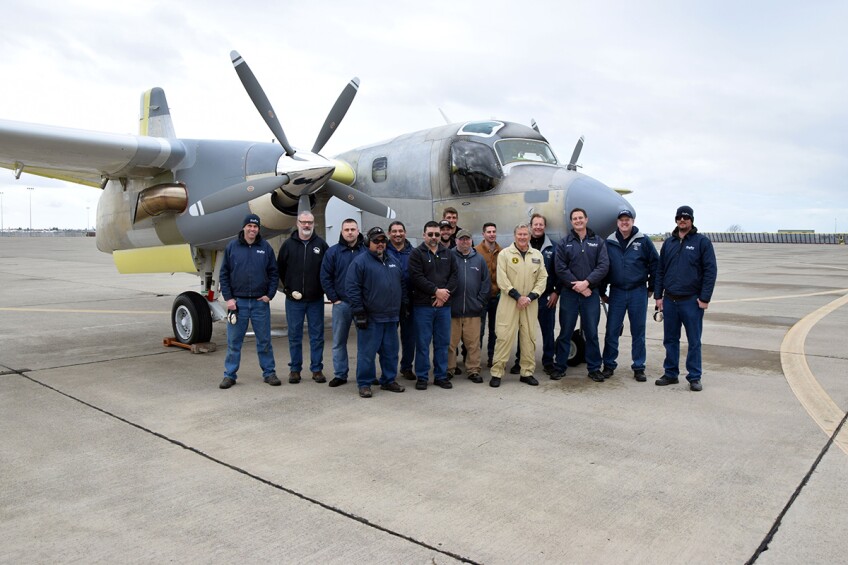
Defeating Fire = Team Effort
Wildland firefighting requires a team effort. Nowhere in the country is that more evident than in California. “Fire touches our lives on a continual basis,” says Walters. Advances in aviation and aerial firefighting have transformed the way fires are fought. Combating the fire from the ground, while simultaneously attacking it from above requires the shared knowledge, skill and tenacity of every team member, be they mechanics, technicians, firefighters or pilots. Each person doing his or her part is the only way to defeat fire, for it is a formidable foe.
Top Image: A helicopter pilot flies over a fire. | Courtesy of Cliff Walters




